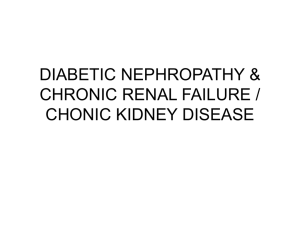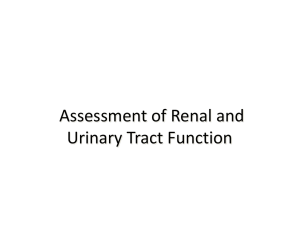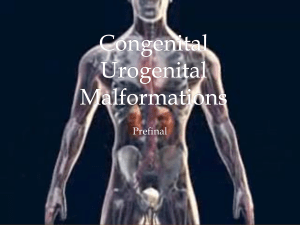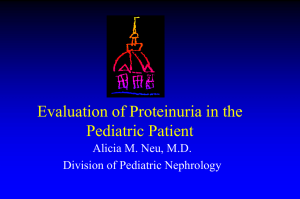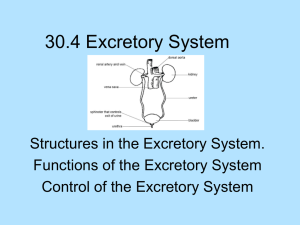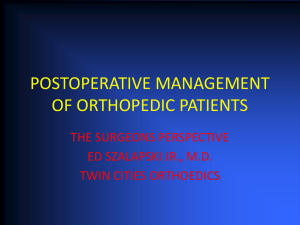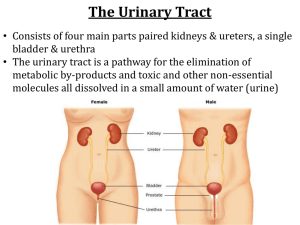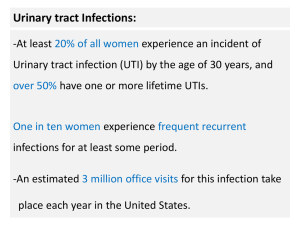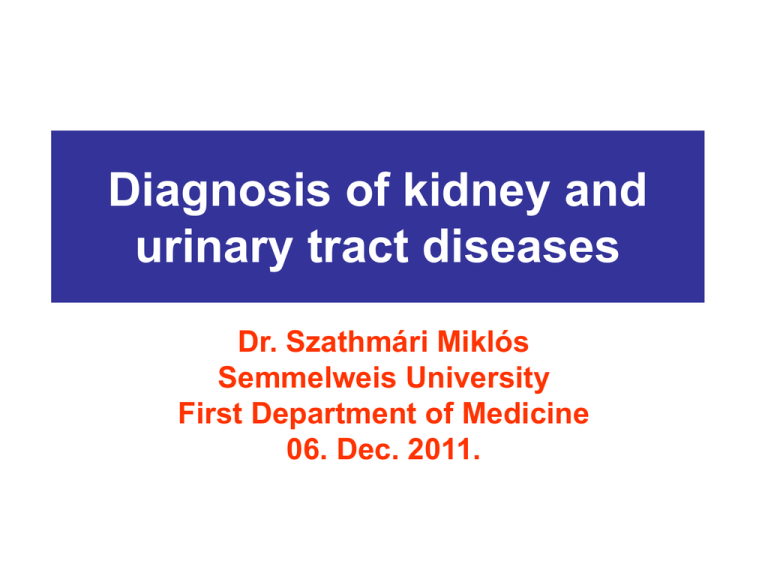
Diagnosis of kidney and
urinary tract diseases
Dr. Szathmári Miklós
Semmelweis University
First Department of Medicine
06. Dec. 2011.
Nephrological syndromes
• Normal kidney function: numerous cellular process to
maintain body homeostasis. Disturbances in any of
these functions leads to constellation of kidney
abnormalities. The clinical manifestation will often be
initially identified as a complex of symptoms, abnormal
physical findings, and laboratory changes.
• Consequence of systemic illnes or occurs as a primary
renal disease
• It consists several elements:
–
–
–
–
Disturbances in urinary volume
Abnormalities of urine sediment
Abnormal excretion of proteins
Reduction of glomerular filtration rate.
• A reduced GFR leads to retention of nitrogenous waste products
(azotaemia) such as creatinine and urea
– Presence of hypertension and/or edema
– Electrolyte abnormalities
– In some syndromes, fever/pain
Urine volume
•
Urine volume
– Normal amount of urine: 1000-2000 ml/day
– Anuria: the complete absence of urine formation
(<50 ml/day)
•
•
•
•
Total urinary tract obstruction
Total renal artery or vein occlusion
Shock
ATN and cortical necrosis can occasionally causes
– Oliguria: 24-h urine output less than 500 m/day
•
•
•
Any cause of acute renal failure
Congestive heart failure
Decreased fluid consumption increased extrarenal fluid loss
– Polyuria: 24-h urine output >3000 ml
•
•
Excretion of nonabsorbable solutes (such as glucose)
Excretion of water (defect of ADH production or renal
responsiveness)
Proteinuria
• Normal individuals excrete <150 mg/d of total protein and
<30 mg/d of albumin
• Detection of proteinuria by dipstick examination
• The dipstick measurement detects mostly albumin
• More exact determination of proteinuria should employ a
24- urine collection or a spot morning protein/creatinine
ratio (mg/g)
– Microalbuminuria: 30-300 mg/d or 30-350 mg/g
– Proteinuria: 300-3500 mg/d or 300-3500 mg/g
– Nephrotic syndrome: >3500 mg/d or >3500 mg/g
• The pattern of proteinuria on urine protein electrophoresis
(UPEP) can be classified as „glomerular”, „tubular” or
„abnormal” depending on the origin of the urine proteins.
– Glomerular selective: mostly albumin (minimal change)
– Glomerular nonselective: all plasma proteins (FSGS)
– Tubular (tubular injury)
– Abnormal proteins (plasma cell dyscrasias)
Types of proteinuria
proteinuria
GLOBULINS
ALBUMIN
<0.15 g/day
PHYSIOLOGICAL
PROTEINURIA
Fusion of glomerular epithelial
cell foot processes.
>1.5g/day
SELECTIVE
PROTEINURIA
Disruption of the basement
membrane (immun complex
diseases). NON-SELECTIVE
0.5-1.5 g/day
PROTEINURIA
TUBULAR
PROTEINURIA
0.1-0.2 g/day
(Tamm-Horsfall
protein)
820
120 69
53
10
Molecular weight (kDa)
Urine sediment analysis
• Prerenal acute renal failure
– „inactive urine sediment”- hyaline casts from normal constituents
of urine – Tamm-Horsfall protein, which is secreted by epithelial
cells of the lopp of Henle
• Postrenal acute renal failure
– „inactive urine sediment” – although hematuria and pyuria are
common
• Acute tubular necrosis
– Pigmented „muddy brown” casts and casts containing
epithelial cells, which suggest an ischemic or nephrotoxic
etiology (together with mild tubular proteinuria)
• Glomerulonephritis
– Red blood cell casts (less often in acute tubulointerstitial
nephritis)
• Interstitial nephritis
– White blood cell casts and nonpigmented granular casts
• Chronic kidney disease
– Broad white blood cell casts (as a sign of dilatation of tubules)
Urine sediment analysis
• Eosinophiluria (>5% of urine leukocytes)
– Antibiotic-induced allergic interstitial nephritis
• Uric acid crystals (pleomorphic in shape)
– Are common in concentrated urine of prerenal
ARF, but can suggest acute urate
nephropathy
• Oxalate (envelope-shaped) and hippurate
(needle shaped) crystals
– Ethylene-glycol ingestion
Reduction of glomerular filtration rate
(GFR)
• Serum creatinine is the most widely used
marker for GFR
– Creatinine derives from muscle metabolism of
creatine.
– Creatinine is useful for estimating GFR because it is a
small, freely filtered solute
– However, serum creatinine levels can increase
acutely from dietary ingestion of cooked meat, and
creatinine can be secreted in the proximal tubule
through an organic cation pathway, leading the
overestimation of the GFR
– The gradual loss of muscle from chronic illnes,
chronic use of glucocorticoids, or malnutrition can
mask significant changes in GFR, with small changes
in serum creatinine concentration
Estimation of glomerular filtration
rate using serum creatinine
concenration, age, sex, race
• Equation from the Modification of Diet in
Renal Disease study (MDRD):
GFR (mL/min per 1.73 m2)=
186,3 x Pcr (e-1.154) x age (e-0.203) x 0.742 (if
female) x 1.21 (if black)
Major syndromes in nephrology
Syndrome
Important clues
Common findings
Acute renal failure
Oligo-anuria
Recent decline in GFR
Hypertension, hematuria,
proteinuria, pyuria, casts,
edema
Acute nephritis
Hematuria, RBC casts,
azotemia, oliguria, edema,
hypertension
Proteinuria, pyuria,
circulatory congestion
Chronic renal failure
Azotemia for >3 month, signs of
uremia, symptoms and signs of
renal osteodystrophia
Proteinuria, casts, polyuria,
nocturia, edema,
hypertension, electrolyte
abnormalities
Nephrotic syndrome
proteinuria>3,5 g per 24 h,
hypalbuminemia, edema,
hyperlipidemia
Casts, lipiduria
Urinary tract obstruction
Azotemia, oliguria-anuria,
urinary retention, slowing of
urinary stream
Hematuria, pyuria, enuresis,
dysuria
Urinary tract infection
bacteriuria>105 colonies/ml,
pyuria, leukocyte casts, bladder
tenderness
Hematuria, mild azotemia,
mild proteinuria, fever
Clinical features for major causes of
acute renal failure (ARF)
• Prerenal ARF (poor fluid intake, NSAID/ACE
inhibitor treatment, worsening heart failure)
–
–
–
–
–
–
Postural hypotension
Low jugular venous pressure
Dry mucus membranes
Decreased circulatory volume
High BUN/creat ratio
SG (specific gravidity) >1018, UNa<10 mmol/l, or
fractional excretion of sodium (FENa <1%)
FENa= UNa x Pcr x 100 /PNa x Ucr
Clinical features for major causes of
acute renal failure (ARF)
• Acute tubular necrosis (ischaemia,
exogenous or endogenous toxins)
– Recent haemorrhage or severe hypotension
– Nehrotoxic antibiotics, chemotherapy, exposure to
radiocontrast
– Rhabdomyolysis (seizures, postictal state, trauma,
statin therapy) –
– Hemolysis – fever, other evidence of recent
transfusion reaction
– Ethylene-glycol ingestion-history of alcohol abuse,
altered mental state
SG<1015, UNa>20 mmol/l, FENa > 1%, urine sediment
Clinical features for major causes of
acute renal failure (ARF)
• Disease of small vessels and glomeruli
(glomerulonephritis/vasculitis)
–
–
–
–
Postinfectious – new cardiac murmur
Autoimmun disease (SLE)- skin rash, arthralgias
Hepatitis B or C
Anti-GBM-disease – sinusitis, lung haemorrhage,
hemoptysis
– ANCA-disease
– Malignant hypertension- evidence of damage to other
organs (heart failure, papilledema, headache)
Hematuria with red cell casts, usually mild proteinuria
Patophysiology of chronic kidney
disease
• Two broad sets of mechanisms of damage:
– Initiating mechanisms specific to the underlying
etiology (immune complexes, toxins)
– A set of progressive mechanisms, involving
hyperfiltration and hypertrophy of remaining viable
nephrons, that are a common consequence following
long-term reduction of renal mass
– The short term adaptations of hypertrophy and
hyperfiltration become maladaptive, as the increased
intraglomerular pressure and flow predisposes to
sclerosis and dropout of the remaining nephrons
Classification of chronic kidney disease
(CKD)
Stage
GFR mL/min per Clinical manifestations
1,73 m2
0
>90
1
≥90
2
60-89
3
30-59
4
15-29
5
<15
Usually not associated with
any symptoms. However,
there may be symptoms
from the undelying renal
disease itself, such as
edema, hypertension.
Most evident complications
include anaemia, easy
fatigability, decreasing
appetite, renal bone
disease.
Uremic syndrome
Uremic syndrome
•
•
•
•
•
•
•
•
•
•
•
•
Sodium and fluid retention – edema
Hypertension
Hyperkalaemia
Metabolic acidosis
Phosphate retention and decreased calcitriol production –
secondary hyperparathyroidism
Cardiovascular abnormlaties (heart failure, left ventricular
hypertrophy)
Pericardial effusion
Anaemia
Neuromuscular abnormalities –muscle cramps, fasciculations,
restless leg syndrome
Uremic feator – urine like odor on the breath, derives from the
breakdown of urea to ammonia in saliva
Gastrointestinal abnormalities – anorexia, nausea, vomiting,
mucosal ulceration at any level of the GI tract
Dermatological abnormalities – pruritus, pallor, the patients may
become more pigmented – deposition of urochroms.
Symptoms, signs and physical diagnostic
of diseases of kidney and urinary tract
• Medical history
–
–
–
–
Previous respiratory tract infection
Dysuria
Kidney stone
Chronic infection,tuberculosis
• Signs
– Edema, acute hypertension, headache –symptoms of
the acute nephritis
– Chronic hypertension – chronic rernal failure
(glomerulonephritis)
– Nausea, vomiting, diarrhea, pruritus – uremia
– Abnormality of the urine amount and color
– Tenderness of kidney region
Clinical features for major causes of
acute renal failure (ARF)
• Diseases of the tubulointerstitium (allergic
interstitial nephritis, acute pyelonephritis)
– Fever, flank pain and tenderness
– Positive blood culture or eosinophilia (allergic nephritis)
– White cell casts, proteinuria, positive urine culture
• Diseases of large renal vessels (renal artery or vein
thrombosis)
– Flank pain
– Mild proteinuria, occasionally hematuria
• Postrenal ARF
– Hystory of renal stones or prostatic disease
– Palpable bladder, flank or abdominal pain
– Urine sediment is usually normal, hematuria due to the stones
Physical examination of the kidneypalpation-percussion
• The normal kidney is generally not palpable
– A normal right kidney may be palpable, especially in
thin patient
– It may be slightly tender
• Enlarged, palpable kidney:
– Polycystic kidney disease (bilateral enlargement)
– Hydronephrosis
– Tumor
• Kidney tenderness (pressure or percussion
in the costovertebral angle with fist)
– Kidney-stone
– Kidney infection
Palpation of the right kidney
Left hand behind the patient, paralell to the 12th rib. Right hand in
the right upper quadrant, lateral and parallel with the rectus muscle.
Lift the left hand, ask the patient to take a deep breath, press right
hand fingers firmly and deeply just below the costal margin, and try
to capture the kidney between your two hands. Ask the patient to
breath out.
Kidney disease - hypertension
• The hypertension is obligatory:
– Acut glomerulonephritis
– Renal artery stenosis (sclerotic or fibromuscular hyperplasia
• Generally will cause hypertension:
–
–
–
–
–
Chronic glomerulopathy
Chronic pyelonephritis
Tubulointerstitial nephritis
Renal microangiopathies (Kimmelstiel-Wilson’s syndrome)
Nephropathies during pregnancy
• Kidney diseases generally without hypertension:
–
–
–
–
Focal nephritisek
Kidney tumors
Amyloidosis
Nephrotic-syndrome


